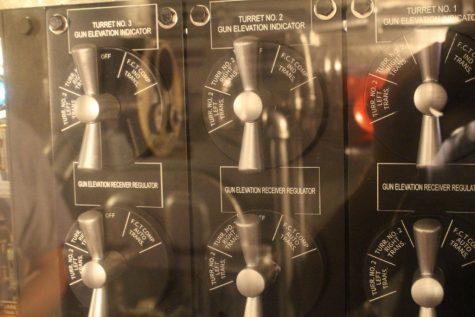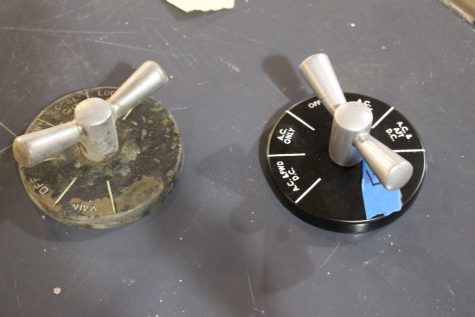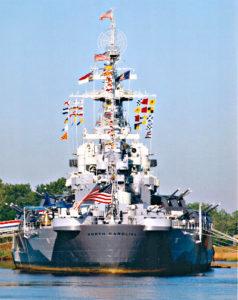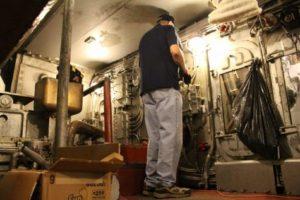Battleship Restoration Volunteers Discover Top-Secret WWII Technology, Turn to 3D Printing to Recreate It for Visitors
 We see 3D printing being used often in military applications; the US Navy especially utilizes the technology for everything from 3D printed missile components and the 3D printed TruClip, to 3D printing items to donate to a veterans’ home. But now, 3D printing is being used to uncover a secret part of history – a group of volunteers who work weekly to restore the battleship U.S.S North Carolina, the most decorated ship in the fleet during World War II, discovered a piece of technology on the ship that was so top-secret, it was censored and blacked out in most images at the time.
We see 3D printing being used often in military applications; the US Navy especially utilizes the technology for everything from 3D printed missile components and the 3D printed TruClip, to 3D printing items to donate to a veterans’ home. But now, 3D printing is being used to uncover a secret part of history – a group of volunteers who work weekly to restore the battleship U.S.S North Carolina, the most decorated ship in the fleet during World War II, discovered a piece of technology on the ship that was so top-secret, it was censored and blacked out in most images at the time.
The volunteers meet every Wednesday morning at the Battleship North Carolina in Wilmington, to help maintain the battleship for visitors, helping out with everything from painting to carpentry.
Pete McWilliams, who helped organize the group, said, “We call ourselves the Wednesday Volunteers. We try to keep it simple. We’re all retired, and we come from a lot of different backgrounds, but we all really love the battleship and its history. So, we’re doing our part to preserve that.”
The group, which has grown from just four members to twenty over the last few years, has also been working recently on restoring the inside of the ship, which includes the interior of its three giant gun turrets, and the fire control systems inside.
The fire control system inside the turrets was an important part of the turrets’ operation. The system, which was considered state-of-the-art for a long time, used a “massive” analog computer to account for many navigational aspects of the ship while it was out on the water, including wind, pitch and roll of the ship, and range. When they say state-of-the-art, they mean it: the fire control system was classified for years, due to how advanced it was. The Navy used this same system when the WWII-era battleships were brought out of hibernation for the Vietnam War. While the Wednesday Volunteers were working in turret number two recently, they made a big discovery.“Initially, we were focusing on repainting and refinishing some interior spaces. Especially the turrets. They’re a big tourist draw, and the sheer amount of traffic coming through here does a number, puts a lot of wear and tear,” said McWilliams.
“What we discovered was a system of synchro-servos, electro-mechanical devices that allowed all the turrets to be used in unison,” said McWilliams. “In the event of a catastrophe, maybe something happened on the bridge, or some other damage, the fire team in this turret could not only bring their three guns to bear, but all nine of the battleship’s big sixteen-inch guns – they could really rain down on the enemy.”
He goes on to explain that when the USS North Carolina set sail in WWII for the Pacific theater, these servos were top-secret:
“If you see pictures from the 1940s, there are often shots where the servos are visible but blacked out, they’re censored because they were top secret.”
While the servo system also allowed the navigation systems of the battleship to be operated from the bridge, their application as fire control was really what made the difference. The USS North Carolina was so effective in combat that it went on to become the most decorated ship in the entire American fleet.

Behind protective Plexiglas, the re-creation of the master fire controls in turret two. [Photo by Benjamin Schachtman]
“I work a lot with STEM programs. For young kids interested in engineering, especially, there is so much to see here, so much to learn. It’s old technology, yeah, but there are so many avenues for students to get into the modern field from here,” said McWilliams.
 As a way to demonstrate what made the battleship so advanced for its time, the group managed to attain some vintage servos. Then, thanks to funding from the non-profit organization Friends of the Battleship North Carolina, the Wednesday Volunteers asked Touchstone 3D, a nearby 3D printing company founded in 2005, if they would create new control elements for the servos, so the volunteers could install them on the ship. Touchstone 3D got its first 3D printer back in 2007, and has worked with military 3D printing before, working on the HABU Mod 1 cheek rest and charging handle for the M4/AR15 weapon line for Falcon 37. The Wednesday volunteers were thrilled with what Touchstone 3D created for them.
As a way to demonstrate what made the battleship so advanced for its time, the group managed to attain some vintage servos. Then, thanks to funding from the non-profit organization Friends of the Battleship North Carolina, the Wednesday Volunteers asked Touchstone 3D, a nearby 3D printing company founded in 2005, if they would create new control elements for the servos, so the volunteers could install them on the ship. Touchstone 3D got its first 3D printer back in 2007, and has worked with military 3D printing before, working on the HABU Mod 1 cheek rest and charging handle for the M4/AR15 weapon line for Falcon 37. The Wednesday volunteers were thrilled with what Touchstone 3D created for them.

Original hardware (left) and 3D printed recreation (right) that the volunteers will use to restore turret two. [Photo Benjamin Schachtman]
“It was a missing piece. You could see the big pieces, the loading mechanism and the gun itself,” said McWilliams. “But this lets you see how the sailors actually used it. You’re that much closer to being there, the way it was in combat.”
Take a look at this 2013 video, to see and learn a little more about the iconic USS North Carolina:
Discuss in the USS North Carolina forum at 3DPB.com.
[Sources/Images: Port City Daily, Battleship North Carolina]
Subscribe to Our Email Newsletter
Stay up-to-date on all the latest news from the 3D printing industry and receive information and offers from third party vendors.
You May Also Like
3D Printing News Briefs, April 13, 2024: Robotics, Orthotics, & Hypersonics
In 3D Printing News Briefs today, we’re focusing first on robotics, as Carnegie Mellon University’s new Robotics Innovation Center will house several community outreach programs, and Ugogo3D is now working...
Rail Giant Alstom Saves $15M with 3D Printing Automation Software 3D Spark
3D Spark has entered into a three-year deal with the rail giant Alstom. Alstom, a transport behemoth with annual revenues of $16 billion, specializes in the manufacture of trains, trams,...
Meltio Expands Global Reach with New Partnerships in the Americas and Europe
Spanish 3D printing manufacturer Meltio has expanded its sales network across the globe. With the addition of three new partners in the United States, Brazil, Argentina, and Italy, Meltio aims...
3D Printing Webinar and Event Roundup: April 7, 2024
Webinars and events in the 3D printing industry are picking back up this week! Sea-Air-Space is coming to Maryland, and SAE International is sponsoring a 3D Systems webinar about 3D...


































